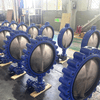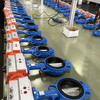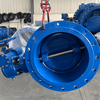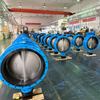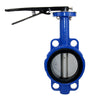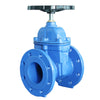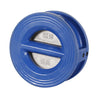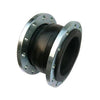Functions and Features of Different Butterfly Valve Actuators
Butterfly valves are a common type of valve used in piping systems. They are primarily used for basic on/off control but can also be effective for throttling applications. The valve operates with a simple 90-degree (quarter-turn) rotation of the disc. When the disc is parallel to the direction of flow, fluid passes through freely. When the disc rotates 90 degrees to a perpendicular position, it completely blocks the passage, stopping the flow.
A butterfly valve actuator is the device that enables this operation, and butterfly valves can be equipped with different actuator types, including manual, gear-operated, electric, pneumatic, and hydraulic actuators. The choice of actuator depends on the installation environment and system requirements. Different types of actuators impact the efficiency and control of the valve. This article explores various actuator types and how they integrate with butterfly valves.
Handle Butterfly Valves
The most common manual actuator for a butterfly valve is a handle. A long handle is connected to the valve stem, and rotating the handle turns the disc to open or close the valve.
There are different types of handles designed to meet specific operational needs. For more details, refer to "Find Your Match: Butterfly Valve Handle Types Explained", which provides insights into their features and applications.

Gear Operated Butterfly Valve
For large butterfly valves (8 inches and above), higher torque is required for operation. These valves are typically equipped with gear-operated handwheels, which feature a gearbox to increase mechanical advantage. The radius of the wheel and the gear ratio determine the level of mechanical advantage provided. Unlike lever-operated valves, these handwheels require multiple rotations to turn the valve disc 90 degrees.
When a valve is installed at a high or hard-to-reach location, a chain wheel attachment is often added to the gearbox of the gear-operated handwheel. This allows remote operation from the ground. The chain forms a long loop that hangs down to an accessible height. To operate the valve, simply pull one side of the chain loop to open it and pull the other side to close it.

Pneumatic Butterfly Valve Actuators
Pneumatic butterfly valve actuators operate by using compressed air to drive an internal piston or diaphragm, which rotates the valve stem to control the opening, closing, or flow regulation of the butterfly valve. When compressed air enters the actuator, it pushes the piston or diaphragm, opening the valve disc. When the air is released, the piston or diaphragm returns to its original position, closing the valve. By adjusting the air pressure, the valve opening can be controlled, allowing for precise flow regulation.
Types of Pneumatic Butterfly Valve Actuators
1. Single-Acting Pneumatic Actuator
Uses compressed air to open the valve, while an internal spring automatically returns the valve to the closed position when the air supply is cut off.
Also known as a spring-return actuator, it ensures fail-safe operation in case of air supply failure.
2. Double-Acting Pneumatic Actuator
Has two air chambers, where air is supplied to one side to open the valve and to the other side to close it.
Lacks a spring-return function, meaning it requires a continuous air supply to maintain the valve’s position.
Both types of actuators are widely used in automated flow control systems, with single-acting actuators preferred for safety applications and double-acting actuators used for more precise and controlled operations.

Electric Butterfly Valve Actuators
Electric butterfly valve actuators use an electric motor to drive the valve stem. When the motor receives an open signal, it starts rotating, turning the valve disc clockwise or counterclockwise until it aligns parallel to the pipeline, fully opening the valve. When a close signal is received, the motor rotates in the opposite direction, positioning the valve disc perpendicular to the pipeline, fully closing the valve. By precisely controlling the motor’s rotation angle, the valve opening can be adjusted to regulate flow.
Electric butterfly valves are often equipped with position feedback devices, allowing real-time valve status monitoring by the control system. This makes them well-suited for remote operation and automated process control.

Hydraulic Butterfly Valve Actuators
Hydraulic butterfly valve actuators are powered by hydraulic pressure (usually oil) to drive the actuator mechanism. When hydraulic oil enters the actuator, it moves a piston or gear mechanism, rotating the valve stem to open the disc parallel to the pipeline, allowing fluid to flow. When the hydraulic oil flows in the reverse direction or is discharged, the disc rotates back to the closed position, stopping the flow.
By adjusting the hydraulic pressure and flow rate, the valve’s opening angle can be precisely controlled, enabling flow regulation.
Like pneumatic butterfly valves, hydraulic actuators come in single-acting and double-acting types:
Single-acting hydraulic actuators use hydraulic pressure to open the valve and rely on spring force to close it when the pressure is released.
Double-acting hydraulic actuators use hydraulic pressure alternately from both sides to control both opening and closing movements.
These actuators provide high torque and precise control, making them ideal for demanding industrial applications where compressed air is insufficient or where high-pressure systems are required.
Specific Applications of Different Actuator Types
The following examples illustrate typical scenarios where different types of butterfly valve actuators are best suited. Understanding these applications can help determine the most appropriate actuator type for various systems.
Handle Butterfly Valve
Ideal for small pipeline systems or applications that do not require frequent operation, such as household water supply pipes, small-scale irrigation systems, or building water distribution systems.
It features a simple structure and low cost, making it suitable for low-flow or low-pressure environments. However, since it requires manual operation, it is not suitable for remote or automated control.
Worm Gear Butterfly Valve
Best suited for medium to large pipeline systems, such as municipal water supply networks, wastewater treatment plants, or industrial cooling water systems.
Provides reduced operating effort, making it suitable for large-diameter or medium-to-high-pressure applications. However, it operates more slowly, making it ideal for applications where quick opening and closing are not required.
Pneumatic Butterfly Valve
Used in industrial processes requiring fast opening and closing or automated control, such as food and beverage production lines, pharmaceutical plants, or chemical processing pipelines for gas and liquid transportation.
Offers quick response times and is suitable for frequent operation and remote control. However, it relies on a stable air supply, which must be available for proper operation.
Electric Butterfly Valve
Ideal for precision control and remote operation in automated systems, such as HVAC (Heating, Ventilation, and Air Conditioning) systems, boiler water supply systems, or industrial automation production lines.
Provides accurate flow regulation and remote control, making it suitable for high-precision or complex control applications.
Hydraulic Butterfly Valve
Designed for high-pressure, large-diameter pipelines, or applications requiring powerful actuation, such as oil and gas transportation pipelines, hydroelectric power plants, or large-scale chemical equipment.
Delivers high thrust and excellent stability, making it suitable for high-pressure, high-flow, or heavy-duty operations. However, it requires a hydraulic system for operation.
Thank you for reading this article. If you are looking to purchase actuated butterfly valves, feel free to contact Union Valve. As a professional butterfly valve manufacturer, we are dedicated to providing high-quality, customized solutions tailored to your specific needs. We look forward to working with you!
Related Article:
-
Posted in
Butterfly valve actuator
